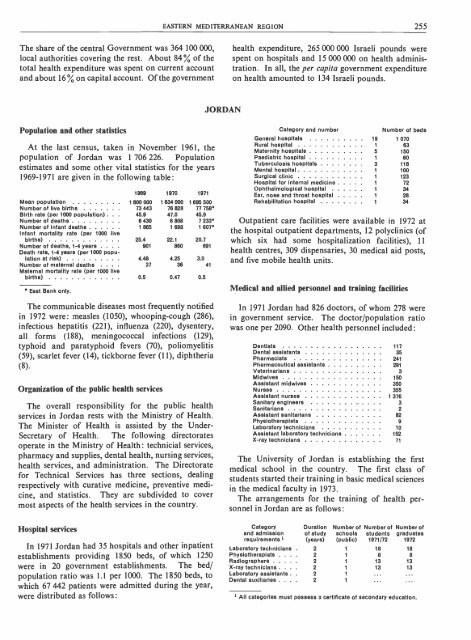FIFTH REPORT - World Health Organization
FIFTH REPORT - World Health Organization
FIFTH REPORT - World Health Organization
Create successful ePaper yourself
Turn your PDF publications into a flip-book with our unique Google optimized e-Paper software.
EASTERN MEDITERRANEAN REGION 255<br />
The share of the central Government was 364 100 000,<br />
local authorities covering the rest. About 84 % of the<br />
total health expenditure was spent on current account<br />
and about 16 % on capital account. Of the government<br />
health expenditure, 265 000 000 Israeli pounds were<br />
spent on hospitals and 15 000 000 on health administration.<br />
In all, the per capita government expenditure<br />
on health amounted to 134 Israeli pounds.<br />
JORDAN<br />
Population and other statistics<br />
At the last census, taken in November 1961, the<br />
population of Jordan was 1 706 226. Population<br />
estimates and some other vital statistics for the years<br />
1969 -1971 are given in the following table:<br />
1969 1970 1971<br />
.<br />
Mean population 1 600 000 1 634 000 1 695 500<br />
Number of live births 73 443 76 828 77 758<br />
Birth rate (per 1000 population) . . 45.9 47.0 45.9<br />
Number of deaths 6 430 6 808 7 233<br />
Number of infant deaths 1 865 1 698 1 607<br />
Infant mortality rate (per 1000 live<br />
births) 25.4 22.1 20.7<br />
Number of deaths, 1 -4 years . . . . 901 860 691<br />
Death rate, 1 -4 years (per 1000 population<br />
at risk) 4.48 4.25 3.0<br />
Number of maternal deaths 37 36 41<br />
Maternal mortality rate (per 1000 live<br />
births) 0.5 0.47 0.5<br />
East Bank only.<br />
The communicable diseases most frequently notified<br />
in 1972 were: measles (1050), whooping -cough (286),<br />
infectious hepatitis (221), influenza (220), dysentery,<br />
all forms (188), meningococcal infections (129),<br />
typhoid and paratyphoid fevers (70), poliomyelitis<br />
(59), scarlet fever (14), tickborne fever (11), diphtheria<br />
(8).<br />
<strong>Organization</strong> of the public health services<br />
The overall responsibility for the public health<br />
services in Jordan rests with the Ministry of <strong>Health</strong>.<br />
The Minister of <strong>Health</strong> is assisted by the Under -<br />
Secretary of <strong>Health</strong>. The following directorates<br />
operate in the Ministry of <strong>Health</strong>: technicial services,<br />
pharmacy and supplies, dental health, nursing services,<br />
health services, and administration. The Directorate<br />
for Technical Services has three sections, dealing<br />
respectively with curative medicine, preventive medicine,<br />
and statistics. They are subdivided to cover<br />
most aspects of the health services in the country.<br />
Hospital services<br />
In 1971 Jordan had 35 hospitals and other inpatient<br />
establishments providing 1850 beds, of which 1250<br />
were in 20 government establishments. The bed/<br />
population ratio was 1.1 per 1000. The 1850 beds, to<br />
which 67 442 patients were admitted during the year,<br />
were distributed as follows :<br />
Category and number<br />
Number of beds<br />
General hospitals 19 1 070<br />
Rural hospital 1 63<br />
Maternity hospitals 5 150<br />
Paediatric hospital 1 60<br />
Tuberculosis hospitals 3 116<br />
Mental hospital 1 100<br />
Surgical clinic 1 123<br />
Hospital for internal medicine 1 72<br />
Ophthalmological hospital 1 34<br />
Ear, nose and throat hospital 1 28<br />
Rehabilitation hospital 1 34<br />
Outpatient care facilities were available in 1972 at<br />
the hospital outpatient departments, 12 polyclinics (of<br />
which six had some hospitalization facilities), 11<br />
health centres, 309 dispensaries, 30 medical aid posts,<br />
and five mobile health units.<br />
Medical and allied personnel and training facilities<br />
In 1971 Jordan had 826 doctors, of whom 278 were<br />
in government service. The doctor /population ratio<br />
was one per 2090. Other health personnel included :<br />
Dentists 117<br />
Dental assistants 35<br />
Pharmacists 241<br />
Pharmaceutical assistants 291<br />
Veterinarians 3<br />
Midwives 150<br />
Assistant midwives 350<br />
Nurses 355<br />
Assistant nurses 1 376<br />
Sanitary engineers 3<br />
Sanitarians 2<br />
Assistant sanitarians 82<br />
Physiotherapists 9<br />
Laboratory technicians 10<br />
Assistant laboratory technicians 152<br />
X -ray technicians 71<br />
The University of Jordan is establishing the first<br />
medical school in the country. The first class of<br />
students started their training in basic medical sciences<br />
in the medical faculty in 1973.<br />
The arrangements for the training of health personnel<br />
in Jordan are as follows:<br />
Category<br />
and admission<br />
requirements 1<br />
Laboratory technicians .<br />
Physiotherapists . . .<br />
Radiographers<br />
X -ray technicians . . .<br />
Laboratory assistants .<br />
Dental auxiliaries . . .<br />
Duration Number of Number of Number of<br />
of study schools students graduates<br />
(years) (public) 1971/72 1972<br />
2 1 18<br />
2 1 8<br />
2 1 13<br />
2 1 13<br />
2 1<br />
2 1<br />
1 All categories must possess a certificate of secondary education.<br />
18<br />
8<br />
13<br />
13
















